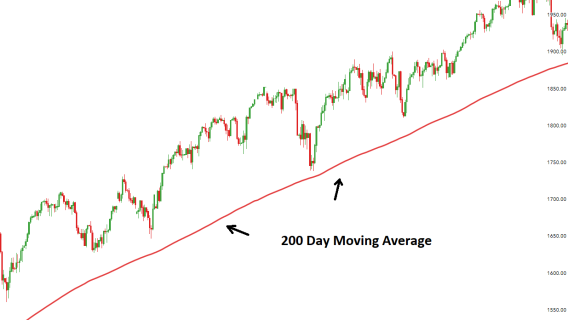Today, I touch on something that appears on almost every stock chart you’ll see, but few investors know how to use: moving averages.
The way I use charts isn’t about chart patterns that you’ve probably heard about (pennants, triangles, head and shoulders, etc.)—for me, it’s all about evaluating supply and demand, picking up clues that tell me whether institutional investors (the ones who control well-traded stocks) are generally buying or selling.
The only two things in the world that are going to give you a direct measure of supply and demand are price and volume. That’s it. Everything else that you might see on a chart is derived from those two things.
If I were forced to limit myself to just two things on a chart, it would be price and volume.
Thankfully, I’m not limited to just price and volume, and I make extensive use of moving averages to help clarify a stock’s standing. As a very brief background, simple moving averages take the last X number of closing prices, add them up and divide by X. Thus, a 50-day moving average basically tells you the stock’s (or index’s) average close during the past 50 trading days. Another, more complicated method is to calculate exponential moving averages, which give more weight to recent closes, but I’ve never used them—I like to keep things simple.
[text_ad]
As it turns out, the 50-day line is probably the most common moving average; I use it as a demarcation line of sorts between an intermediate-term uptrend and downtrend. On a daily chart, I also use 25-day (shorter-term) and 200-day (longer-term) moving averages.
There’s no perfect way to use moving averages to your advantage—heck, there’s nothing special or sacrosanct about the 25-, 50- and 200-day moving averages. But I do have some helpful hints (some basic, some more advanced) that can improve your buying and selling.
Tips for Using Moving Averages
1. On the buy side, moving averages (MAs) are an easy way to eliminate those tempting story stocks that really aren’t performing. I have NEVER bought a stock that’s trading below its 200-day moving average, and have rarely bought one below its 50-day line. Simply put, if a stock is below these MAs, it’s not in an uptrend. It’s fine to watch it, but not to plow into it.
2. On the sell side, if a stock has been above its 50-day line for many weeks, and then breaks it decisively (for more than a few hours, on above-average volume, by a meaningful amount, etc.), it’s a sign the intermediate-term uptrend is over.
3. As a follow-up to #2, for individual stocks, you can use the same theory with a 25-day moving average at times. In other words, if a stock is super-strong and has been trending above its 25-day line for eight, 10, or 12 weeks in a row, and then it decisively breaks it, you can usually use that as a time to sell (or trim) your position, instead of waiting for the 50-day average to break.
4. On the flip side to #2 and #3, if a stock is base building for many weeks, and then pops back above its 50-day line, you can often buy some (or add a little to your existing position) right there.
5. I know many investors like to follow moving average crossovers, i.e., when the 50-day line falls below the 200-day line on the chart, it’s a sell—the so-called “Death Cross.” (Insert foreboding music here.) But I’ve never found much value in crossovers, as they tend to lag too much; if MAs themselves are secondary to price and volume, then MA crossovers are secondary to MAs ... and that’s one secondary too many for me.
6. One technique I learned back in the early 2000s is how to use moving averages to avoid getting into a stock too early. Say a stock is base building, then comes to life and quickly moves to new highs. Well, if the 25-day line is still below the 50-day line, it’s usually the case that the breakout attempt won’t work—it’s telling you the stock still needs time to set up. This doesn’t apply to a huge earnings gap, for instance, but it can help you avoid buying into what turns out to be a failed breakout.
7. As for buying at support on the 25-day or 50-day line, I’m all for it—in fact, institutional investors love to do that because there’s usually a chance to grab a good amount of shares. My only advice is to keep a relatively tight stop in place; if you’re buying at the line, the stock should find support very soon. If it doesn’t, the basis for the trade was wrong, so you should move quickly to cut the loss.
8. Lastly, I know many investors like to use the 50-day MA as a trailing stop of sorts. I’ve heard of worse ideas, but just remember that (a) tons of investors watch the 50-day line, which can lead to some false breakdowns, and (b) MAs, in general, should be considered fences that can be leaned upon, not hard-and-fast exact levels of support. Thus, the 50-day line is vital, but it’s best used as one selling tool among many.
All in all, I’ve always found moving averages to be helpful with my own chart analysis. They’re not the be-all and end-all, but they can improve your trading by strengthening your buy and sell decisions.
[author_ad]
*This post has been updated from a previously published version.

